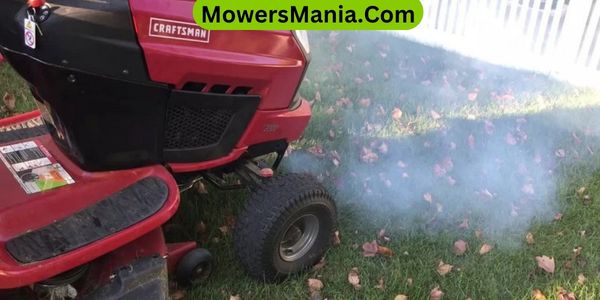Is your lawn mower puffing out smoke? Find out why in this quick guide. Learn how overfilled oil, dirty air filters, and other issues can cause your mower to smoke.
Keep your lawn mower running smoothly with these simple tips.

Overfilled Oil
If your lawn mower is smoking and emitting a burning smell, it may indicate that you have overfilled its oil. Overfilling the oil in your lawn mower can lead to serious problems.
The excess oil can get into the combustion chamber and mix with the fuel, causing the engine to emit smoke and a burning odor.
This can also lead to potential damage to the engine components, such as the spark plug, and affect the overall performance of the mower.
To address this issue, first, stop the lawn mower immediately and allow it to cool down. Then, carefully remove the excess oil by draining it from the oil tank.
It’s crucial to ensure that the oil level is at the recommended capacity to prevent any further smoking or damage to the engine.
After the excess oil has been removed, you can restart the lawn mower and monitor for any signs of smoking or burning smell. If the problem persists, it may be necessary to seek professional assistance to inspect and repair any potential damage caused by the overfilled oil.
Dirty Air Filter
One common cause of smoking and poor performance in your lawn mower is a clogged air filter, which restricts airflow to the engine. When the air filter becomes dirty or clogged with debris, it prevents a sufficient amount of clean air from reaching the engine.
As a result, the engine may produce excessive smoke and experience a decrease in power and efficiency.
A dirty air filter can lead to the accumulation of dirt, grass clippings, and other debris, which hinders the proper air intake necessary for combustion within the engine.
This restricted airflow can cause the engine to run too rich, meaning it has an excessive amount of fuel compared to the available air. This imbalance can result in the emission of white or blue smoke from the exhaust and may also lead to rough idling or stalling.
To address this issue, it’s important to regularly inspect and clean or replace the air filter according to the manufacturer’s recommendations.
By maintaining a clean air filter, you can ensure that your lawn mower operates efficiently and minimizes the risk of smoking and performance problems.
Worn Spark Plug

If your lawn mower is smoking, a worn spark plug could be the culprit. When the spark plug is worn, it can lead to incomplete combustion, causing excessive oil consumption and emitting smoke.
To fix this issue, simply replacing the spark plug can often solve the problem and get your lawn mower running smoothly again.
Faulty Spark Plug
Experiencing smoking from your lawn mower may indicate a faulty spark plug, particularly from wear and tear over time.
A worn spark plug can cause your mower to emit smoke and perform poorly. When the spark plug is worn, it may not ignite the fuel-air mixture properly, leading to incomplete combustion and the production of smoke.
You can easily check the spark plug for signs of wear, such as a worn electrode or a damaged insulator. If you notice any of these signs, it’s essential to replace the spark plug with a new one to ensure proper combustion and prevent smoking.
Regularly inspecting and replacing worn spark plugs can help maintain your lawn mower’s performance and reduce smoke emissions.
Excessive Oil Consumption
When your lawn mower’s spark plug becomes worn, it can lead to excessive oil consumption, causing smoke and decreased performance. A worn spark plug can fail to ignite the fuel properly, leading to unburned fuel and oil in the engine.
This can result in the production of blue or white smoke from the exhaust, indicating that oil is being burned along with the fuel.
Additionally, the engine may experience decreased power and efficiency due to the improper combustion process. To address this issue, you should regularly inspect and replace the spark plug according to the manufacturer’s recommendations.
Faulty Carburetor
When your lawn mower is smoking, it’s likely due to a faulty carburetor. The carburetor is responsible for mixing air and fuel in the right proportions for combustion in the engine. When it malfunctions, it can lead to an overly rich fuel mixture, causing the engine to smoke excessively.
One common issue with a faulty carburetor is a stuck or leaking float. The float controls the fuel level in the carburetor bowl, and if it gets stuck or the needle valve is worn out, it can lead to an overflow of fuel into the engine, resulting in smoke.
Another potential problem is a clogged carburetor. Dirt, debris, or old fuel can clog the carburetor, disrupting the air-fuel mixture and causing the engine to emit smoke.
Additionally, a carburetor that’s out of adjustment can also cause smoking. If the air-fuel mixture is too rich, it can lead to excessive smoke.
Regular maintenance and cleaning of the carburetor can help prevent these issues. If you notice smoke coming from your lawn mower, it’s essential to address the faulty carburetor to prevent further damage to the engine.
Improper Fuel Mixture
To address the issue of smoking from your lawn mower, examine the fuel mixture, as an improper ratio of air to fuel can lead to excessive smoke.
Here are a few things to consider when it comes to the fuel mixture:
- Check the Fuel Ratio: Ensure that you’re using the correct fuel-to-oil ratio if you have a 2-stroke engine. Using too much oil can lead to incomplete combustion and cause smoking.
- Inspect the Air Filter: A clogged or dirty air filter can disrupt the air-fuel ratio, leading to a rich fuel mixture and excessive smoke. Regularly clean or replace the air filter as needed.
- Adjust the Carburetor: If the carburetor is set to deliver too much fuel, it can result in a rich mixture and smoking. Consider adjusting the carburetor to achieve the correct fuel-to-air ratio.
- Use Fresh Fuel: Stale or old fuel can cause combustion issues, leading to smoking. Always use fresh, clean fuel and avoid using fuel that has been sitting for too long.
Damaged Engine Components

If your lawn mower is smoking, it could be due to damaged engine components. Worn piston rings and an overfilled oil reservoir are common culprits.
These issues can lead to excessive oil consumption and combustion, resulting in the noticeable smoke coming from your mower.
Worn Piston Rings
First, check the piston rings for wear if your lawn mower is smoking excessively. Worn piston rings can allow oil to seep into the combustion chamber, causing excessive smoke.
Here’s how to check for worn piston rings:
- Remove the spark plug and pour a small amount of oil into the cylinder.
- Reinstall the spark plug and try starting the mower.
- If the smoke clears up after a few minutes of running, it indicates worn piston rings.
- Another way to check is by performing a compression test. Low compression levels can also indicate worn piston rings.
If you observe these signs, it’s best to consult a professional to inspect and replace the worn piston rings to prevent further damage to your lawn mower.
Overfilled Oil Reservoir
Excessive oil in the reservoir can lead to damaged engine components, such as the catalytic converter or the exhaust system, causing your lawn mower to emit smoke.
When the oil level is too high, it can result in the oil being splashed around the engine, leading to it burning and producing smoke. The excess oil can also put pressure on the seals and gaskets, causing them to fail and allowing oil to leak into the combustion chamber. This can lead to oil burning and smoke emission.
Moreover, the overfilled oil reservoir can result in increased internal pressure, leading to oil leaks and potential damage to the engine’s components.
To resolve this issue, it’s crucial to drain the excess oil and ensure the oil is filled to the recommended level.
Frequently Asked Questions [FAQs]
What Are the Potential Dangers of Continuing to Use a Smoking Lawn Mower?
Continuing to use a smoking lawn mower can pose serious dangers. The smoke could be a sign of engine trouble or oil leakage, which can lead to a fire hazard. It’s important to address the issue promptly.
Can I Still Use My Smoking Lawn Mower, or Should I Stop Using It Immediately?
You should stop using the smoking lawn mower immediately. Continuing to use it can lead to serious damage and pose a safety risk. It’s best to have it checked by a professional.
How Can I Prevent My Lawn Mower From Smoking in the Future?
To prevent your lawn mower from smoking in the future, regularly clean or replace the air filter, check the oil level, and ensure proper fuel mixture. Also, keep the mower blades sharp and avoid overfilling the oil.
Are There Any Temporary Fixes I Can Try Before Taking My Lawn Mower to a Professional?
Before taking your lawn mower to a professional, try cleaning or replacing the air filter, ensuring the oil level is correct, and inspecting the spark plug. These temporary fixes may resolve the smoking issue.
What Are the Most Common Causes of Smoking Lawn Mowers, and How Can I Identify Which One Is Causing the Issue?
The most common causes of smoking lawn mowers are oil or gas overflow, damaged engine components, or a clogged air filter. To identify the issue, check for leaks, inspect the spark plug, and clean the air filter.
Conclusion
So, if you notice your lawn mower smoking, don’t panic. Check the oil level, clean the air filter, and inspect the spark plug.
If the issue persists, it might be a faulty carburetor or improper fuel mixture. In any case, it’s best to consult a professional for further diagnosis and repair.
With the right maintenance and care, you can keep your lawn mower running smoothly and smoke-free.



